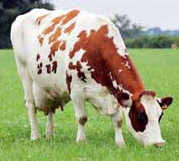



Mongolian
History
The Ancestors of todays modern Mongolian cattle were Asian wild cattle (Bos turano mongolicus). This breed is native to Inner Mongolia and northern China. It was not until 1949 that Mongolian cattle began to be improved with crossbreeding to European breeds. The Shorthorn was the first to be crossed.Mongolian cattle have been herded for centuries by nomads and they are used by farmers as draft animals and are highly valued for their meat.
They are found in two varieties, the Ujumqin and Halhïn Gol.
Characteristics
Mongolian cattle are usually brindle or reddish brown in colour but will sometimes be black, yellow or pied. The hair and skin is thick with small dewlaps and humps, the horns are quite thin and long.Their bone structure is very strong and sturdy and they have stocky body types with low, narrow hindquarters and good udder conformation. They stand approximately 110cm tall which is relatively small to other breeds, adult cows weigh between 280 and 400kg and bulls 550 and 600kg. It can take up to 7-8 years for the Mongolian to reach its full size although studies have been done to show if high quality food supplements are given the growth rate increases. Body weight and conformation of Mongolian cattle are influenced greatly by the type of natural grassland on which they are reared. Cattle kept on pasture, steppe, semi-desert-steppe and desert have a tendency to become increasingly smaller in that order.
Milk production is influenced by natural conditions and nutritional level, as well as by calving (lactation) number and stage of lactation. Ujumqin cows may produce 500-600 kg of milk in a 5-month lactation with good nutrition in the grass-growing season, the fat content being about 5 percent. Daily milk yield is highest in the first month, then gradually declines during the 5-month lactation period.
Mongolian heifers first come on heat at the age of 8-12 months, but are not used for breeding until 2 years of age. There is a breeding season from April to November, but most cows are bred from May to September because of marked seasonal differences in climate and condition of the grassland.
Statistics
Comparative
Distribution
The Mongolian is one of the most popular among Chinese indigenous cattle breeds. It is located mainly in Inner Mongolia, but is also widely distributed in the northeast, north, and northwest.References (the above information was cited from the following sites)
www.ansi.okstate.edu
www.embryoplus.com
Mongolia Today Science, Culture, Environment and Development by Dendeviin Badarch, Raymond A. Zilinskas and Peter J. Balint.


